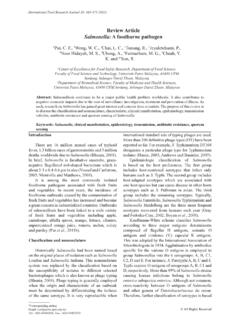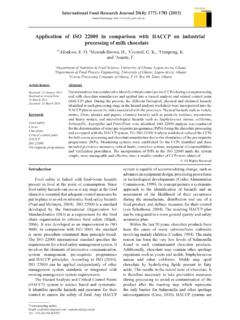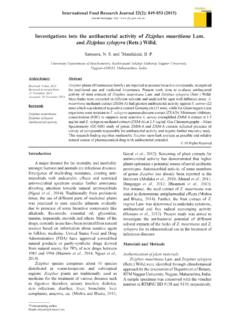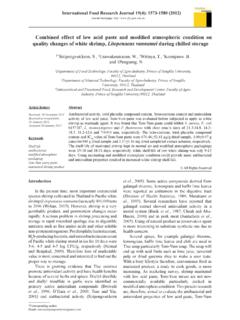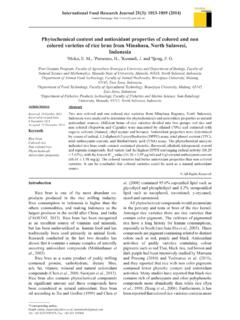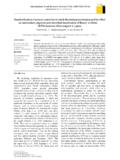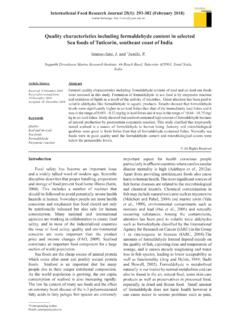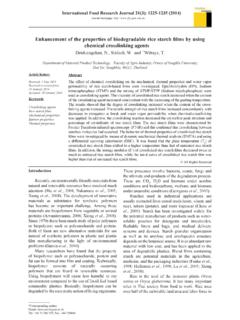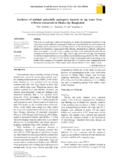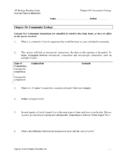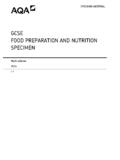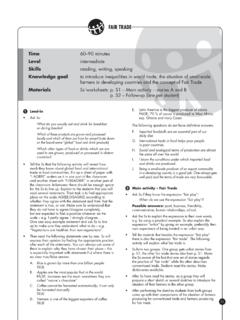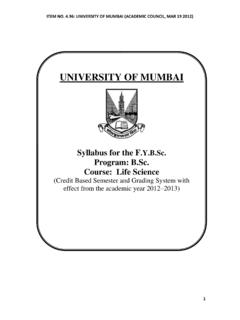Transcription of MiniReview Health promoting bioactive …
1 All Rights Reserved*Corresponding author. Email: Tel: +91-2692271601; Fax: +91-2692271602 International food Research Journal 19(1): 141-152 (2012)Kumar, S. and Andy, of Rapeseed-Mustard Research, Sewar, Bharatpur 321 303(Rajasthan), India MiniReviewHealth promoting bioactive phytochemicals from BrassicaAbstract: Brassica vegetables are a family of 6 agriculturally important species consumed in high quantities throughout the world. Cruciferous vegetables are a good source of many Health promoting and potentially protective phytochemicals including folic acid, phenolics, carotenoids, selenium, glucosinolates and vitamin C. Incorporating these potent plant based compounds in a daily food is a safe, effective and inexpensive way to guard against many of today s most common and lethal cancers of which nearly 30-40% are directly linked to improper diet and related factors.
2 The present paper reviews the available literature on bioactive compounds from edible crucifers, their Health promoting beneficial effects and possible role in imparting defence against diseases especially : Bio active compounds, structure, distribution, activity, brassicaceae, rapeseed, mustardIntroduction Plant and animal foods, in addition to supplying essential nutrients for the mankind also possess a variety of bioactive substances like phenols, flavonoids, carotenes and organo sulphur compounds having anti proliferative activities (Plumb et al., 1997). Nearly 30-40% of cancers are directly linked to improper diet and related factors (Czapski, 2009).
3 Epidemiological studies indicated positive association between intake of fruits and vegetables and reduced mortality from common cancers, heart and other degenerative diseases (Art et al., 2005; Kaur et al., 2001; Scalbert et al., 2005; Vita, 2005). Cruciferous vegetables are a family of 6 agriculturally important species consumed in high quantities throughout the world (Fahey et al., 2001). Brassica oleracea is the main vegetable species of this family including kale, cabage, broccoli, Brussels sprouts, cauliflower whereas vegetable forms of Brassica rapa include turnip,Chinese cabbage and pak choi (Cartea et al., 2011). Cruciferous vegetables are a good source of many Health promoting and potentially protective phytochemicals including folic acid, phenolics, carotenoids, selenium, glucosinolates and vitamin C (Howard et al.)
4 , 1997; Femina et al., 1998; Kushad et al., 1999; Conaway et al., 2001; Fimognari et al., 2002) and offer powerful, broad-spectrum support for protecting against the ubiquitous cancer provoking agents encountered every day in our environment and have been reported to be associated with a lower incidence of certain cancers of lung, colon, breast, ovary and bladder (Higdon et al., 2007; Fowke 2007; Juge et al., 2007; Zhao et al., 2007). Mustard leaves have been reported to possess many bioactive substances and antioxidant properties (Kim et al., 2003). Mustard leaves extract has also been observed to control glucose metabolism and reduced lipid per oxidation as well as the level of oxygen radicals ameliorating the damage caused by oxidative stress (Yokozawa et al.
5 , 2003). Tiku et al., (2008) also recorded the protective effect of Brassica campestris leaves against in vivo chromosomal damage and oxidative stress induced by gamma radiation and genotoxic chemicals. Incorporating these potent plant based compounds in a daily food is a safe, effective and inexpensive way to guard against many of today s most common and lethal cancers. Earlier reviews appeared dealing with biocidal, bio herbicidal, anti oxidant, anti cancer activities of glucosinolates and their products from Brassicaceae (Rosa et al., 1997; Fahaey et al., 2001; Zukalova and Vasak 2002; Halkier and Gershenzon 2006; Vig et al.
6 , 2009). However, published information on other bioactive compounds from this family is very limited. The present paper reviews the available literature on bioactive compounds from edible crucifers, their Health promoting beneficial effects and possible role in imparting defence against diseases especially and hydrolysis Glucosinolates are sulphur containing secondary metabolites. The structure of the glucosinolates consists of a -D glucose moiety linked to a sulphated thiohydroximate (Figure1). The moiety linked to thiohydroximate or side chain varies and resulting into about 130 different types of glucosinolates (Fabre et al., 2007).
7 It could be aliphatic, aromatic or indolyl 142 Kumar, S. and Andy, food Research Journal 19(1): 141-152(Table 1).Desulphoglucosinolates, the penultimate compounds in the glucosinolates biosynthetic pathways are oximes having pka values about 9-12 (Jencks and Regenstein 1968; Underhill 1980). Due to low pka value of the sulphonic acid group, GSLs invariably occur in anionic form in nature (Larsen, 1981 Prestera et al., 1996). Presence of glucose moiety and ionic forms makes glucosinolates hydrophilic and non-volatile compounds (Larsen, 1981). RCH2 OHSNH2 OOHOHOSO3 -HOGlucos inol ateS. nameTrivial name R Aliphatic12-propenyl (allyl)SinigrinCH2=CH-CH223-butenylGluco napinCH2=CH-CH2-CH234-pentenylGlucobrass icanapinCH2=CH-CH2-CH2-CH244-methylthiob utylGlucoerucin(CH3) S(CH2)453-methylsulphinyl propylGlucoiberinCH3SO(CH2)364-methylsul phinylbutylGlucoraphaninCH3SO(CH2)475-me thylsulphinylipentylGlucoallysin(CH3)SO( CH2)583-methylthiopropylGlucoibervirin(C H3)S(CH2)
8 3 II Hydroxy aliphatic102-hydroxy-3-butenylProgoitrin CH2=CH-CHOH-CH2112-hydroxy-4-pentenylNap oleiferinCH2=CH-CH2 CHOH- CH2 III Cyclic124-hydroxy benzylSinalbin13 PhenethylGluconasturtiin14 BenzylGlucotropaeolin IV Heterocyclic153-indolylmethylGlucobrassi cin161-methoxy-3-indolylmethylNeoglucobr assicin174-hydroxy-3-indolyl methyl4-hydroxy-glucobrassicin184-methox y-3-indolyl methyl4-Methoxy-glucobrassicinGlucosinol ates are non-toxic per se. However, their hydrolytic bioactive products derived from cleavage by myrosinase (thioglucoside glucohydrolase; EC (Fenewick, 1983), a medium molecular weight protein, co-existing in tissues of Brassica species forming an unstable aglcuone intermediate; the unstable aglucone then eliminates sulphate by Lossen rearrangement (Figure 2).)
9 Depending on factors such as pH, unstable intermediate spontaneously degrades to one of a number of products (Rouzaud et al., 2004; Ugolini et al., 2008]. Low pH tends to favour production of allylcyanide, however, under neutral and alkaline pH conditions allyl isothiocyanate is formed as predominant breakdown product of sinigrin (Uda et al., 1986). In presence of epithiospecifer protein, 1-cyano-2,-epithiopropane can also be formed (Cole, 1978). Epithionitriles and oxazoldine-2-thiones are formed from glucosinolates with a hydroxyl group at the 2-position of the side chain. Process of cooking vegetables destroys much of the naturally available myrosinase, however, glucosinolates can still be converted to isothiocyanates inside the body but much less efficiently than when myrosinase is available.)
10 The conversion can occur in the colon where native gut bacteria hydrolyze the glucosinolates (Getachum and Hung, 1999; Johanson, 2002).DistributionMore than 100 glucosinolates have been identified from 16 plant families such as Cruciferae (syn. Brassicaceae), Bataceae, Bretschneideraceae, Pentadiplandraceae, Phytolaccaceae, Pittosporaceae, Resedaceae, Capparaceae, Moringaceae, Tropaeolaceae, Tovariaceae, Limnanthaceae, Caricaceae, Gyrotemonaceae, Salvadoraceae and Euphorbiaceae (McGregor and Downey, 1975; Kjaer, 1980; Fahey et al., 2001; Fabre et al., 2007). They mainly occur in the Brassicaceae, which includes the crop plants such as rapeseed-mustard, cabbage, cauliflower, broccoli and Brussels sprouts (Table 2).
